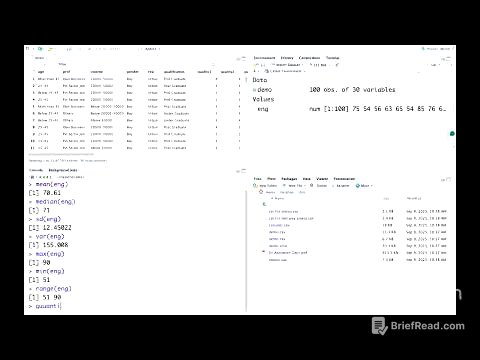TLDR;
Alright, so this video gives a breakdown of filters, focusing on active and passive types. It explains what filters are, how they're classified, and the pros and cons of active versus passive filters. Key takeaways include active filters offering flexibility in gain, no loading issues, and cost-effectiveness, while passive filters don't need a DC power supply and can handle higher frequencies.
- Filters are frequency selective circuits.
- Active filters use active components like op-amps, while passive filters use resistors, capacitors, and inductors.
- Active filters are generally better but have limitations in frequency range and power handling.
Introduction to Filters [0:02]
The video starts off by explaining that filters are frequency-selective circuits. Their main job is to allow a specific range of frequencies to pass through while blocking or reducing others. Filters can be classified in a few ways: analog or digital, passive or active, and audio or radio filters. The video will mainly focus on active and passive filters, discussing their advantages, disadvantages, and best use cases.
Passive Filters Explained [1:10]
Passive filters only use passive components like resistors, capacitors, and inductors. They don't use any active components like transistors, MOSFETs, or op-amps. Because of this, passive filters have a frequency response that isn't very sharp, and they work best at lower frequencies.
Active Filters Explained [1:43]
Active filters, on the other hand, use active components like transistors, MOSFETs, and op-amps, along with passive components. This means active filters can have a much sharper frequency response and can operate at higher frequencies compared to passive filters. Active filters generally have more advantages than passive ones.
Advantages of Active Filters [2:19]
Active filters have several advantages. First, they offer flexibility in gain and frequency adjustment because they use op-amps. The gain of an op-amp can be easily adjusted. Also, active filters don't have the loading problems that passive filters do, because op-amps have high input resistance and low output resistance. Active filters are also more economical because cheaper op-amps are available, and they don't always need inductors, which can be expensive. Plus, active filters have no insertion loss, meaning the signal doesn't get attenuated in the passband. You can also easily adjust the passband gain using op-amps. Active filters also provide input isolation and impedance control, and they can use smaller components because of the finite gain bandwidth product of op-amps. Finally, you can often avoid using inductors altogether, which simplifies the circuit and reduces costs.
Disadvantages of Active Filters [6:34]
Despite the advantages, active filters also have some downsides. They need a DC power supply to operate the active components like op-amps. Also, they're limited in their frequency range because op-amps have a finite gain bandwidth product. This means active filters are best for low to moderate frequencies. Finally, they can't handle large amounts of power because of power dissipation in the active components.
Applications of Active Filters [7:56]
Active filters are best used in applications where you need a low to moderate frequency range and less power dissipation. This includes things like communication equipment, biomedical equipment, radar equipment, and other electronic circuits.









